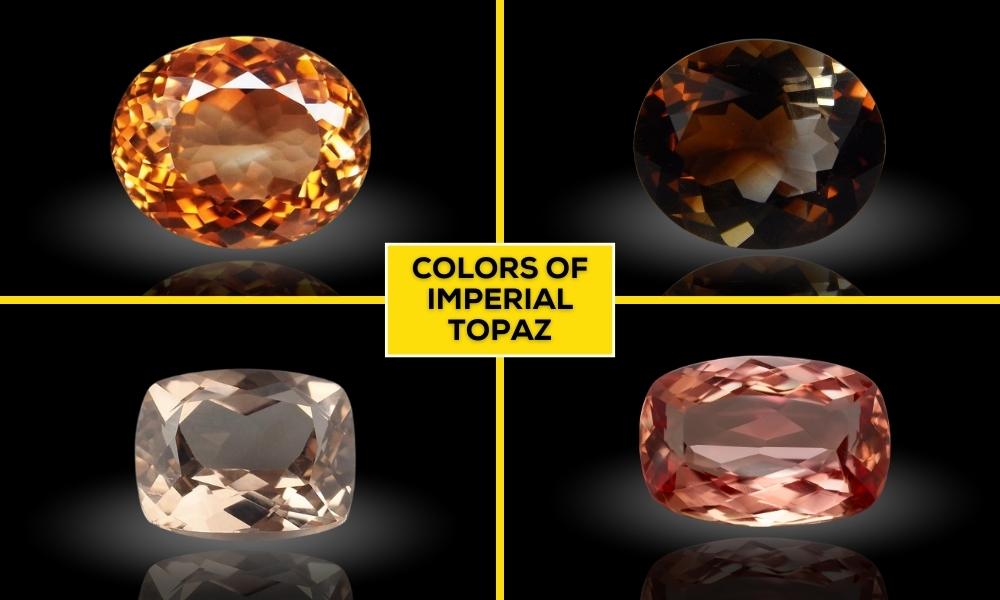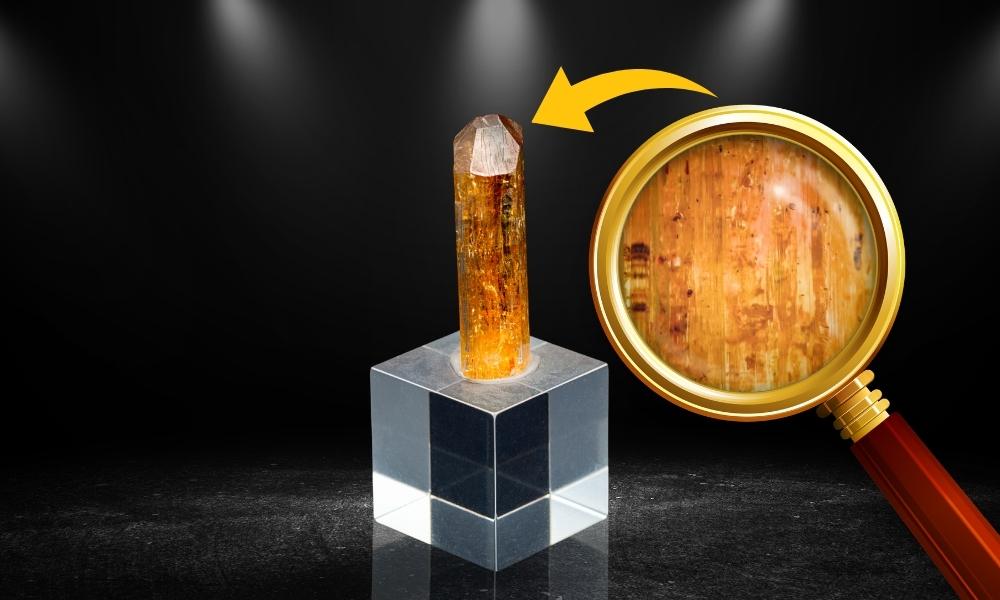The ‘emperor’ of Topazes and one of the world’s most coveted rare gemstones, Imperial Topaz was christened in honor of Brazilian Emperor Dom Pedro as it embodies imperial (yellow-orangeish-pink) shades with a soft velvety luster. A common myth associates this stone with the imperial power of Russia; it gets the name of Brazilian Topaz adorning jewels worn by Tsarinas.
The golden incandescence of the late afternoon, the reddish-yellow and orange one of a sunset, followed by dawn’s flaming pink in Topaz. Since up to 90% of all gems are red, blue, or green, the imperial colors have the highest demand.
Expert cutting is very essential in all the Topaz and its most expensive variety, the Imperial Topaz. Strongly dichroic (two colors visible when viewed from different angles) with one color usually darker than the other, the Topaz needs proper orientation or its dark streak may over-concentrate at two ends of a finished stone and it will have an in-homogeneous appearance.
Imperial Topaz is also an evening gem which due to its transparency and high refraction looks amazing in the low light, having a distinct attractive pinkish tint under candle-light (incandescent) lighting.
Imperial topaz belongs to the variety of one silicate mineral from the aluminum and fluorine – topaz. You can distinguish topaz by its deep, warm, and also reddish-orange to pinkish-orange hue. This stone is one of the most coveted and high-priced varieties of topaz because it has very vivid tints and is often used in Topaz Ear Studs.
Table of Contents
Colors of Imperial Topaz

Warm and vivid hues ranging from deep orange to reddish-orange, peach, and pinkish-orange are characteristic of imperial topaz. Within this broad range, the gemstone can display a spectrum of colors, and color intensity plays a major role in evaluating the gemstone’s worth. The richest, most intense colors of topaz stones are highly valuable.
Within the imperial topaz category, the following distinct color variations are found:
Deep Orange
Deep orange hues in imperial topaz might mimic the warm tones of a sunset. For this gemstone, this is among the most sought-after and traditional hues.
Reddish-Orange
A reddish-orange color may be present in some imperial topaz stones, giving the gem’s overall warmth a hint of pink or red.
Peach
The color of lighter imperial topaz tones might be peachy or apricot. The more vibrant and saturated hues, albeit still lovely, are usually valued higher.
Pinkish-Orange
Imperial topaz occasionally has a pinkish-orange hue that blends soft pink undertones with warm orange tones.
It is important to note that people use the “imperial topaz” term for orange to pinkish-orange topaz. Other varieties of topaz might be blue, yellow, or brown. Chromium and iron which are the trace elements, influence the color of topaz. Natural defects and inclusions can also cause the stone to look very imperfect. The color of the gemstone is a very important consideration in defining its quality and also value, with richer colors that are more vibrant attracting premium prices.
Clarity of Imperial Topaz

Although imperial topaz’s clarity varies, it is usually clear to translucent gemstones. The inclusions, or internal features impact the overall clarity of the stone. In the realm of gemstones, a gem’s clarity has a significant impact on both its beauty and value.
The following are some typical features of its clarity:
Eye-Clean
A large number of imperial topaz gemstones are eye-clean, which means that no inclusions are visible to the unaided eye. Because of their exceptional transparency and clarity, these stones are highly valuable.
Typical Inclusions
Imperial topaz, like many other gemstones, may have naturally occurring inclusions like veils, small crystals, or voids filled with liquid. It could take magnification to see these inclusions because they might not be immediately apparent.
Flaws and Imperfections
Defects or faults impact the clarity of some imperial topaz stones. These could consist of interior features such as cleavages or fractures. The degree, position, and visibility of these flaws determine how they affect clarity.
In the world of gemstones, people rate clarity on a scale that ranges from eye-clean to different types of visible inclusions and subsequent impact on the value. Such as the Gemological Institute of America and other gem labs offer grading reports that include many details on a stone’s clarity along with several other features.
It’s important to point out, however, that the clearer gemstones are usually more precious but the value of clarity can vary based on the type of mineral. The best topaz is a gem with good transparency and also minimum visible inclusions. But, collectors and people may have different tastes; the beauty of stone as a whole has always been mattering in subjective terms.
Cutting of Imperial Topaz

It is essential to cut topaz, or any gemstone for that matter properly to maximize its aesthetic value and bring out its beauty. The goal of gem cutters is to cut facets that bring out the color, clarity, and overall brilliance of the stone. The final piece of jewelry that is intended as well as the topaz’s inherent crystal shape might influence the cut selection.
Taking into account the following factors when cutting topaz
Faceting Styles
People often cut Imperial topaz in a variety of ways, including pear, emerald, cushion, oval, and round shapes. The faceting style selection affects the gemstone’s color display and the way light interacts.
Brilliance and Fire
Gem cutters cut Imperial topaz to provide the best possible brightness and fire. Fire is the spread of ghostly hues, whereas brilliance is the amount of white light reflected to the observer. The balance of both is necessary for a well-cutting of topaz.
Color Orientation
To bring out the best hue, the cutter must take the gem’s color orientation into account. This entails determining how to cut the stone to emphasize or minimize particular color qualities and comprehending the crystal’s inherent color zoning.
Carat Weight Considerations
The cutter should take into account the intended carat weight of the completed gem. An important part of cutting is striking a balance between the necessity for good color, clarity, and brightness and the need for a larger stone.
Shape and Symmetry
The final cut’s symmetry and form are essential to the gem’s overall visual appeal. In general, symmetrically cut and well-proportioned stones have a more appealing appearance.
It is worth mentioning that an experienced specialist who possesses a very high level of skill and precision should perform the gem-cutting process to ensure good quality. The cut has an equally important role in evaluating the value and aesthetics of imperial topaz as it is with any other gemstone.
Imperial Topaz is Rare

With an unusual crystal structure, the Topaz is not only beautiful but it is also hard and dense because it comes in different stunning colors. The blues, yellows, and browns in the topaz are due to color centers, the reds and pinks result from chromium while oranges come from both chromium and/or color center Modern enhancements nowadays offer a variety of different color options for Topaz in the gem market.
While you may find Topaz in Burma, Mexico, Mozambique, Nigeria, Pakistan, Russia, Sri Lanka, the USA, and Ukraine, the Brazilian state of Minas Gerais (English: Mines General) is still the ultimate source. Any Topaz to come from Brazil goes by the name of Imperial and traditionally, only those gems derived purely in that country are referred to as ‘Imperial Topaz.’
Prices of Imperial Topaz

The quality affects the cost of topaz, just like any other gemstone. However, some generalizations are possible. You may find the most common variety of blue topaz seen today in jewelry for about $25 per carat. at retail for ring sizes. Higher sizes can be slightly above. Although natural blue topazes abound, the vast production of treated blues has practically sent them in terms of their synthetic counterparts.
These stones also include the colorless topaz from which blue topaz is made (irradiated and heat treated) that is found in sizes over 100 cts. and larger, and it sells for less than $8 per ct. Brown Topaz fetches similar prices.
Instead, the expensive orange topaz (called ‘imperial’ topaz) costs over $1000 per carat. for large (10ct.+) sizes, The most expensive topaz is pink or red and can cost up to $3500 per carat. at retail. In sizes above 5 cts, they are often a rarity.
(FAQs) about Imperial Topaz
Q1. Is imperial topaz rare?
Yes, imperial topaz is very rare.
Q2. What is the difference between topaz and imperial topaz?
Topaz is an inexpensive blue gemstone for the majority of today’s jewelry consumers. The rich golden to reddish-orange color of the highly sought-after “imperial topaz” is mostly found near Ouro Preto, Brazil.
Q3. Why is Imperial Topaz so expensive?
If you can locate one, a trader can set the price for the finest red topaz, which are “as rare as hen’s teeth”! Because Imperial Topaz is so uncommon, it is also highly precious.
Q4. Which topaz is the most expensive?
The most precious variety of topaz is imperial topaz. Its brilliant golden orange-yellow tint is tinged with deep pink or scarlet.
Q5. Which color topaz is best?
People historically prefer a topaz with a bright yellow color. These days, blue is most likely the most popular (and affordable) topaz hue. Imperial topazes are rare and precious stones that might be pink or reddish-orange. These are just a handful of the hues that these gems can display.
Stay Tuned to Gems Tycoon for all gems-related articles.









